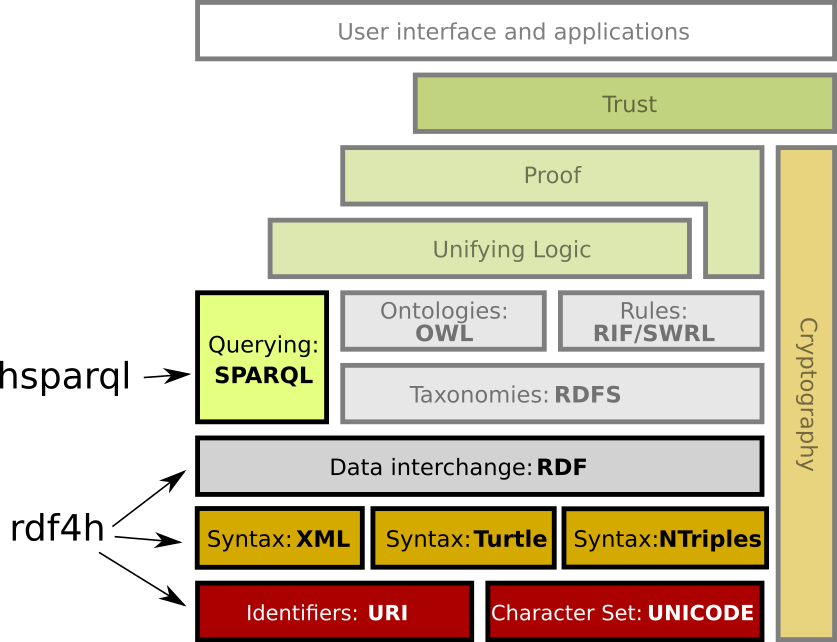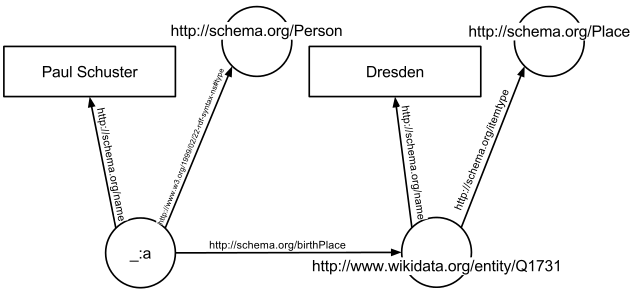rdf4h RDF for Haskell
Overview
The rdf4h Haskell library is for querying structured data described with the the Resource Description Framework model, where data is a collection of <subject,predicate,object> triples:


Rdf type class
The following Rdf type class methods are optimised for each graph implementation.
class Rdf a where
baseUrl :: RDF a -> Maybe BaseUrl
prefixMappings :: RDF a -> PrefixMappings
addPrefixMappings :: RDF a -> PrefixMappings -> Bool -> RDF a
empty :: RDF a
mkRdf :: Triples -> Maybe BaseUrl -> PrefixMappings -> RDF a
addTriple :: RDF a -> Triple -> RDF a
removeTriple :: RDF a -> Triple -> RDF a
triplesOf :: RDF a -> Triples
uniqTriplesOf :: RDF a -> Triples
select :: RDF a -> NodeSelector -> NodeSelector -> NodeSelector -> Triples
query :: RDF a -> Maybe Node -> Maybe Node -> Maybe Node -> Triples
showGraph :: RDF a -> StringThe Data.RDF.Query module contains more utility query functions,
here.
Building RDF graphs interactively
An RDF graph can be constructed with empty, and its triples contents
modified with addTriple and removeTriple, e.g.:
{-# LANGUAGE OverloadedStrings #-}
module Main where
import Data.RDF
main :: IO ()
main = do
-- empty list based RDF graph
let myEmptyGraph = empty :: RDF TList
-- add a triple to the empty graph
triple1 = triple
(unode "http://www.example.com/rob")
(unode "http://xmlns.com/foaf/0.1/interest")
(unode "http://dbpedia.org/resource/Scotch_whisky")
graph1 = addTriple myEmptyGraph triple1
-- add another triple to the graph
triple2 = triple
(unode "http://www.example.com/rob")
(unode "http://xmlns.com/foaf/0.1/interest")
(unode "http://dbpedia.org/resource/Haskell_(programming_language)")
graph2 = addTriple graph1 triple2
-- remove one of my interests
graph3 = removeTriple graph2 triple1
putStrLn (showGraph graph3)Bulk RDF graphs with parsing and writing
RDF graphs can also be populated by parsing RDF content from strings, files or URLs:
class RdfParser p where
parseString :: (Rdf a) => p -> T.Text -> Either ParseFailure (RDF a)
parseFile :: (Rdf a) => p -> String -> IO (Either ParseFailure (RDF a))
parseURL :: (Rdf a) => p -> String -> IO (Either ParseFailure (RDF a))RDF graphs can also be serialised to handles with hWriteRdf:
class RdfSerializer s where
hWriteRdf :: (Rdf a) => s -> Handle -> RDF a -> IO ()E.g. to write an RDF graph to a file:
withFile "out.nt" WriteMode (\h -> hWriteRdf NTriplesSerializer h rdfGraph)Supported RDF serialisation formats
The rdf4h library supports three RDF serialisations:
| Serialisation | Reading | Writing |
|---|---|---|
| NTriples | ✓ | ✓ |
| Turtle | ✓ | ✓ |
| RDF/XML | ✓ | ✗ |
Type level RDF graph representations
The RDF type is a data family, for which there are a number of
instances. Those instances represent type level indexes that provide
the programmer with the choice of underlying in-memory graph
representation.
data family RDF a
-- function provided a (s,p,o) triples based RDF graph.
foo :: RDF TList -> Bool
foo rdfGraph = ...
-- function provided a hash based adjacency map RDF graph.
bar :: RDF AdjHashMap -> [Triple]
bar rdfGraph = ...Those implementations differ in their in-memory representation of RDF graphs.
-
RDF TListstores triples as Haskell lists, i.e.[(s,p,o),..]. The implementation. -
RDF AdjHashMapis an adjacency hash map with SPO and OPS indexes. The implementation.
TList implementation
Given two triples:
1 (s: "http://example.com/rob_stewart",
p: "http://xmlns.com/foaf/0.1/interest",
o: "http://dbpedia.org/resource/Semantic_Web")
2 (s: "http://example.com/rob_stewart",
p: "http://xmlns.com/foaf/0.1/interest",
o: "http://dbpedia.org/resource/Haskell_(programming_language)"The TList implementation just stores them as is, i.e.
[ Triple (UNode "http://example.com/rob_stewart")
(UNode "http://xmlns.com/foaf/0.1/interest")
(UNode "http://dbpedia.org/resource/Semantic_Web")
, Triple (UNode "http://example.com/rob_stewart")
(UNode "http://xmlns.com/foaf/0.1/interest")
(UNode "http://dbpedia.org/resource/Haskell_(programming_language)")AdjHashMap
The adjacency hash map implementation has two hash map implementations:
-
A hashed S key pointing to value that is another hash map, whose key is a hashed P pointing to a hash set of O values.
-
A hashed O key pointing to value that is another hash map, whose key is a hashed P pointing to a hash set of S values.
So our two-triple graph is stored in SPO and OPS indexes:
hash "http://example.com/rob_stewart" == -1527025807618695980
hash "http://xmlns.com/foaf/0.1/interest" == -2021146143382594279
hash "http://dbpedia.org/resource/Semantic_Web" == 3091419593178925190
hash "http://dbpedia.org/resource/Haskell_(programming_language)" == -8705743210846359529
-- SPO map
(k: -1527025807618695980
v: (k: -2021146143382594279
v: [3091419593178925190,-8705743210846359529]))
-- OPS map
(k: -8705743210846359529
v: (k: -2021146143382594279
v:[-1527025807618695980])
,
k: 3091419593178925190
v: (k: -2021146143382594279
v:[-1527025807618695980]))This makes querying AdjHashMap graphs with query very efficient,
but modifying the graph with addTriple and removeTriple more
expensive that the TList implementation, which just use (:) and
filter respectively.
The TList and AdjHashMap data family instances represent
application specific tradeoffs in terms of space and runtime
performance. TList performs better for query, whilst AdjHashMap
performs better for select and modifying triples in a graph with
addTriple and removeTriple. See
these criterion results
for performance benchmarks, taken in November 2016.
RDF query example
module Main where
import Data.RDF
import qualified Data.Text as T
eswcCommitteeURI, heldByProp :: T.Text
eswcCommitteeURI =
"http://data.semanticweb.org/conference/eswc/2015/program-committee-member"
heldByProp = "swc:heldBy"
-- full names of ESWC 2015 conference programme committee.
eswcCommitteeMembers :: RDF TList -> [T.Text]
eswcCommitteeMembers graph =
let triples = query
graph
(Just (unode eswcCommitteeURI))
(Just (unode heldByProp))
Nothing
memberURIs = map objectOf triples
in map
(\memberURI ->
let (LNode (PlainL firstName)) =
objectOf $ head $
query
graph
(Just memberURI)
(Just (unode "foaf:firstName"))
Nothing
(LNode (PlainL lastName)) =
objectOf $ head $
query
graph
(Just memberURI)
(Just (unode "foaf:lastName"))
Nothing
in (T.append firstName (T.append (T.pack " ") lastName)))
memberURIs
main :: IO ()
main = do
result <- parseURL
(XmlParser Nothing Nothing)
"http://data.semanticweb.org/dumps/conferences/eswc-2015-complete.rdf"
case result of
Left err -> error "Unable to parse RDF content from that URL"
Right rdfGraph -> do
let eswcMemberNames = eswcCommitteeMembers rdfGraph
mapM_ (putStrLn . T.unpack) eswcMemberNamesThe list of the Extended Semantic Web Conference 2015 programme committee members is printed to standard out:
> main
Vadim Ermolayev
Karl Aberer
Giorgos Stoilos
Birgitta König-Ries
Giuseppe Rizzo
...Here is an example of computing if the structure of two RDF graphs are identical, using the hgal library.
Tests
This library has two test suites:
- Property based tests of the API using QuickCheck. All tests pass.
- Unit tests provided by the W3C to test conformance of RDF parsers, of which there are currently 521. Some parsing tests fail currently.
To list the available tests that can be run in isolation using a pattern:
$ stack test --test-arguments "--list-tests"To run specific test groups:
$ stack test --test-arguments="--pattern TList"Please contribute!
Pull requests should be submitted to the rdf4h GitHub repository: https://github.com/robstewart57/rdf4h
It’d be great to have:
- High performance RDF graph implementations
- Support for RDF quads, i.e. named RDF graphs
- Support for JSON RDF serialisation ticket 34
- RDFS/OWL inference engines
- Parser performance improvements, e.g. ticket 35
- Criterion profile guided API performance optimisations
In more detail…
High performance RDF graph implementations
Wanted: new Rdf type class instances providing new high
performance RDF graph representations, beyond the three instances the
library currently has.
The latest set of criterion benchmark results (November 2016) are here. To run the criterion benchmarks locally:
$ wget https://www.govtrack.us/data/rdf/bills.099.actions.rdf.gz
$ gzip -d bills.099.actions.rdf.gz
$ stack benchOr to run just the benchmarks for a specific RDF implementation, use
the --benchmark-arguments flag, e.g.:
$ stack bench --benchmark-arguments 'rdf4h/query/AdjHashMap'
...
Benchmark rdf4h-bench: RUNNING...
benchmarking rdf4h/query/AdjHashMap SPO
time 506.4 ns (505.0 ns .. 507.8 ns)
1.000 R² (1.000 R² .. 1.000 R²)
mean 505.8 ns (504.4 ns .. 507.3 ns)
std dev 5.087 ns (3.939 ns .. 6.874 ns)